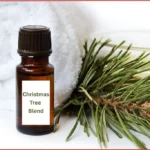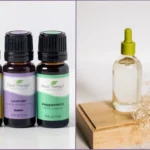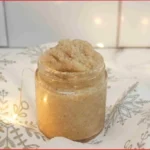Learning how to make rose oil is an easy way to bring a subtle, natural aroma to your everyday routine.
There’s something timeless about the gentle scent of roses. Homemade rose-infused oil lets you capture that natural aroma naturally, while giving your daily routine a touch of luxury.

✨ Get 12 Free Holiday Diffuser Blends — Printable PDF
Instantly make your home smell like Christmas with these festive, ready-to-use recipes.
This simple process offers a fragrant oil that adds softness to skin and a calming boost to self-care rituals.
Making rose oil at home means you know exactly what goes into your blend and enjoy the process from start to finish.
This guide covers how to make rose oil with dried and fresh petals without any special equipment. You need only two ingredients to make an infused oil that works in massages, DIY beauty blends, or relaxing baths.
Table of Contents
Affiliate Disclosure: Some links on this site are affiliate links. I may earn a small commission if you purchase through them, at no extra cost to you. See the full affiliate disclosure.
What Is Rose Infused Oil?

Rose oil is a fragrant oil made by infusing or steeping rose petals into a carrier oil such as coconut, jojoba, or sweet almond oil.
The infusion process ruptures the cell walls of the rose petals, drawing out their natural scent and gentle color. The resulting infused oil traps everything good about the blooms in a bottle.
Making rose-infused oil at home lets you capture the pure, true-to-life aroma of real roses. Every batch carries the gentle, authentic scent of real rose petals—nothing artificial, just nature in a bottle.
You can make rose oil with dried petals or fresh petals using a couple of different infusion techniques.
Before diving into the details, I do want to emphasize that this relates to making rose-infused oil, not rose essential oil. There’s a big difference between the two. Use the table of contents to skip directly to the difference between rose-infused oil and rose essential oil.
Rose Oil Benefits for Skin, Hair & Personal Care
There are plenty of reasons to keep a bottle of rose oil in your bathroom or on your vanity. Here’s why it’s a favorite in self-care routines:
- Natural fragrance: Add uplifting, floral notes to your favorite skin and bath care products without chemicals.
- Softens skin: Use as a body or face oil to boost moisture and softness.
- Soothes the senses: The gentle scent helps create a calming vibe during baths or massages.
- Multi-use: Works in hair treatments, bath oils, and even homemade scrubs.
- Personal touch: Custom blends let you control the scent and strength, making it perfect for gifts or personal rituals.
What You’ll Need to Make Rose Oil: Dried Petals vs Fresh Petals
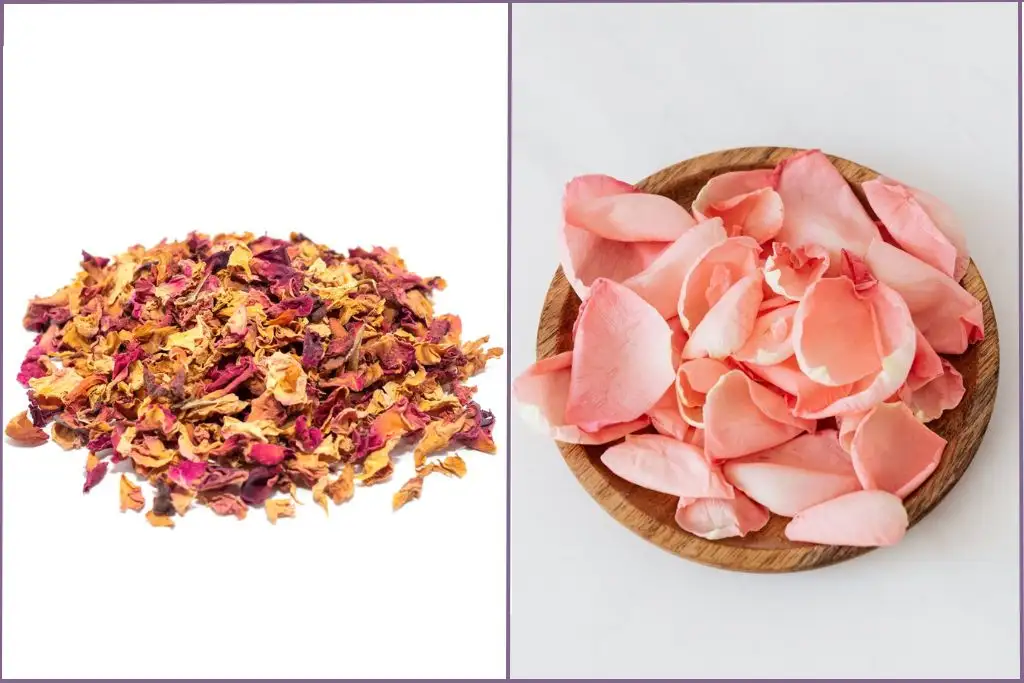
The key to making beautiful, aromatic rose oil starts with the right ingredients. Choosing high-quality roses and the best carrier oil sets the stage for a product that smells amazing and feels wonderful on your skin.
Here’s what to look for when getting started with how to make rose oil.
Choosing the Right Roses
For the best results, always start with organic, pesticide-free roses. Roses from your garden are ideal, as you know exactly how they’re grown.
Store-bought bouquets are tempting, but unless labeled organic, they often contain chemicals that you don’t want in your final oil.
There are two main choices when it comes to rose petals for infusing oil:
Fresh Rose Petals: Fresh petals give your oil a bright, clean scent. The color and fragrance of the petals you pick will influence your finished oil. Deep pink or red roses tend to give the richest scent.
Dried Rose Petals: Dried petals bring an earthy, concentrated aroma. These are perfect if fresh blooms aren’t available or when you want to make oil out of season.
You can dry fresh petals by spacing them on a screen in a cool, dry spot, or buy food-grade dried rose petals from a reputable supplier. Ensure the petals are completely dry before using to prevent mold or bacteria in your oil.
No matter which you choose, always avoid roses sprayed with chemicals or artificially dyed petals. Sticking to organic and all-natural blooms keeps your homemade rose oil pure and safe.
Selecting the Best Carrier Oil for Infusing Rose Petals

The oil you use for the infusion is just as important as the roses themselves.
The carrier oil acts as a base, pulling the scent and properties from the petals while nourishing your skin.
Different oils have different effects and suit different needs.
Here’s a quick guide to help you choose:
Jojoba Oil
- Closest to your skin’s own oil (sebum).
- Lightweight, absorbs quickly, and doesn’t feel greasy.
- Great for all skin types, but especially good if you want a non-clogging option for the face.
Sweet Almond Oil
- Mild scent that lets the rose fragrance shine.
- Rich in vitamin E and perfect for dry or sensitive skin.
- Glides on easily, making it a favorite for massages.
Fractionated Coconut Oil
- Heavier oil that’s ideal for dry areas like elbows and feet.
- Has a subtle coconut scent that can blend well with roses but can slightly alter the floral aroma.
- Solid at cooler temps, so consider fractionated (always liquid) coconut oil for a smoother finish.
Grapeseed Oil
- Very light with a silky texture that absorbs quickly into the skin.
- High in antioxidants and vitamin E, making it gentle for sensitive or oily skin types.
- Won’t leave a heavy residue, so it’s ideal if you prefer a barely-there feel.
Argan Oil
- Packed with fatty acids and vitamin E to nourish and moisturize deeply.
- Adds a subtle, nutty scent that pairs well with rose’s delicate aroma.
- Especially helpful for dry or mature skin, and works well for hair treatments too
When deciding which carrier oil to use, think about how you’ll use your rose oil:
- For body massages or as a bath oil: Sweet almond oil gives a rich, soft feel.
- For facial oil: Jojoba is light and absorbs quickly.
- For deep moisture: Coconut oil is thick and deeply hydrating.
- For everyday use: Grapeseed oil is absorbed quickly into the skin.
- For dry or mature skin: Argan oil moisturizes deeply.
Always choose cold-pressed, unrefined oils to keep the final product as natural as possible. These options hold onto nutrients, adding more benefit to your home-infused rose oil.
With the right roses and carrier oil in hand, you’re all set to move on to the next step in how to make rose oil that’s both fragrant and skin-friendly.
How to Make Rose Oil with Dried Petals
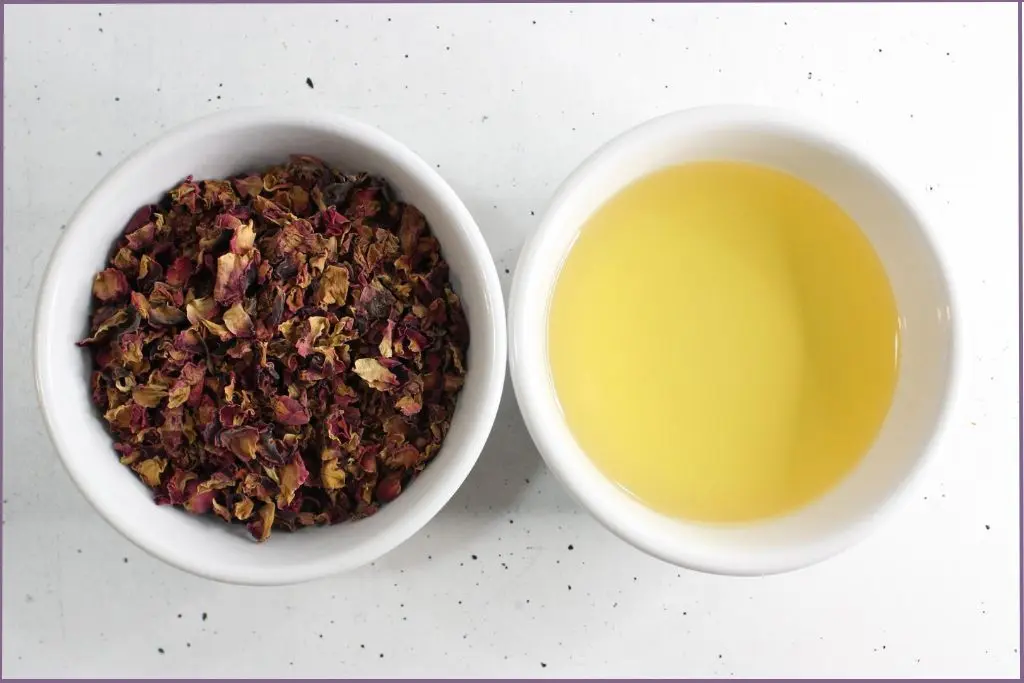
Dried roses are easy to keep on hand and offer a rich, long-lasting aroma when used for oil infusions.
As you will see below, making rose oil with dried petals is simple. Dried petals soak up the base oil, releasing a deeper scent that’s perfect for daily wellness rituals.
Let’s break down how to get the most from your dried roses, starting with the right prep, then looking at two tried-and-true ways to infuse the petals into your chosen oil.
Ingredients:
- 1 cup Dried Rose Petals
- 2 cups Carrier Oil
- Clean, Dry Glass Jar with a Tight-Fitting Lid
- Clean, Dry Container for storing the finished oil
Prepare the Dried Rose Petals
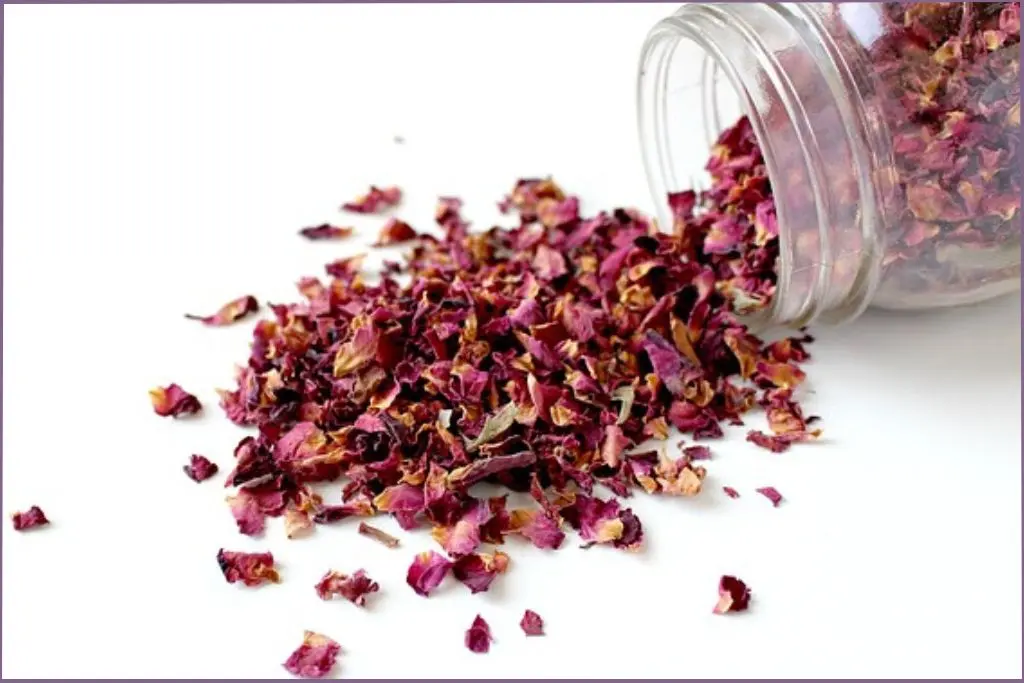
Preparing the dried petals is an important first step in making a rose-infused oil that’s clean, fragrant, and safe to use.
Use only food-grade dried petals from a trusted supplier, or petals you dried yourself from untreated roses.
Check that the petals are bone-dry. Even slight dampness or softness can cause the oil to spoil or mold.
Inspect petals for dust, bits of stem, or any bugs. Gently shake them out before use.
For better and faster infusion, lightly crush the petals by rubbing gently between clean palms or pressing them with a spoon. While not a mandatory step, this can help expose more surface area, meaning more rose scent gets released into your oil.
Don’t crush the petals too fine as very small pieces can slip through the strainer during the next stage.
A little extra care at this stage goes a long way in making rose oil that’s pure and long-lasting.
Infusion Methods for Dried Petals
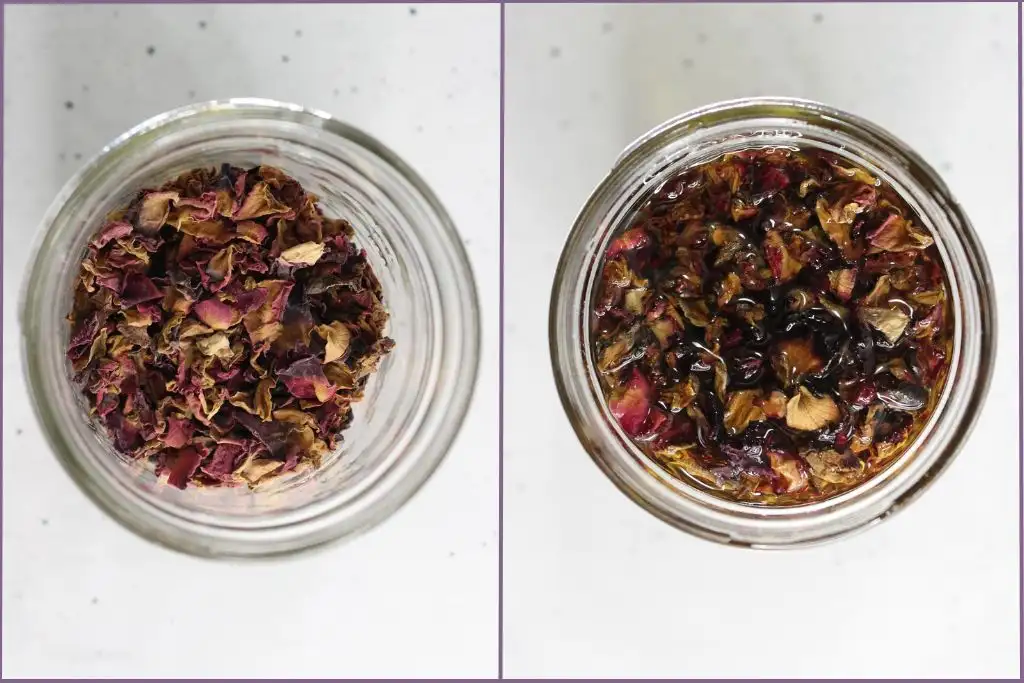
With your dried rose petals ready, it’s time to infuse their scent and color into your favorite carrier oil. There are two easy and effective methods: cool infusion and warm infusion (using gentle heat).
Cool Infusion Method
This classic approach uses time and patience to gently draw out the scent and color from dried rose petals. The process is hands-off, letting nature do most of the work.
Put the dry rose petals into a clean glass jar, leaving enough space to add the carrier oil.
Pour the carrier oil over the petals, covering the petals fully with the oil. Fill the jar to the top to prevent air exposure.
Seal the jar tightly and swirl gently to mix the petals and oil.
Place the jar in a cool, dark place for 2-4 weeks, gently swirling it every few days to help the infusion process.
The longer you let the petals infuse in oil, the stronger the scent of the infusion.
After 2-4 weeks (depending on how strong you want the aroma) strain the oil through a strainer or cheesecloth to remove the rose petals.
Squeeze the cloth to extract as much of the oil as possible. Discard the used petals
Cool infusion is gentle and preserves the natural scent and properties of the petals well, since it avoids high temperatures that can break down nutrients.
It is ideal when you’re not in a rush and want a beautifully scented, rich oil for skin and hair.
Pros of cold infusion to make rose oil:
- Preserves the pure, fresh scent of roses.
- Less risk of degradation of the petals due to heat.
- Gentle extraction keeps color bright.
Cons of cold infusion to make rose oil:
- Takes longer – expect to wait about 2-4 weeks.
Note: You need to be careful about moisture at all steps.
Warm Infusion Method
The warm infusion method is a useful, speedier process when you want your rose oil immediately. This approach uses gentle, consistent heat to speed the extraction, giving you finished oil in a few hours.
Place your dried petals and oil in a clean, heat-safe glass jar or bowl.
Set the container in a double boiler, slow cooker, or saucepan filled with a couple of inches of water. Keep the water below a simmer.
Let the oil and petals warm gently for 2 to 3 hours. Maintain a low temperature, never let it boil as high heat damages the delicate components of the petals.
Stir occasionally to help release the color and fragrance.
Strain while still warm, using a fine mesh strainer or cheesecloth.
Warm infusion works well when you want results fast. The major trade-off is that some subtle scents and nutrients can be lost with prolonged heat, but most carrier oils and rose petals handle gentle warming just fine.
Pros of warm infusion to make rose oil:
- Ready in just a few hours.
- Releases scent and color quickly.
Cons of warm infusion to make rose oil:
- Heat can sometimes mute the delicate fragrance.
- Petals can cook if the temperature gets too high, so gentle heat is a must.
Summary Table: Cold vs. Heat Infusion to Make Rose Oil
| Infusion Method | Infusion Time | Scent Result | Best For |
| Cold Infusion | 2-4 weeks | Fresh, delicate | Gentle aroma |
| Hot Infusion | 2-3 hours | Strong, hearty | Fast results |
Which infusion method is best?
Both options are great for making aromatic rose-infused oil. Just match your method to your schedule and preference for scent.
If preserving the most natural scent and beneficial parts of the rose is your top goal, choose cool infusion.
Warm infusion is best if speed matters to you.
Whichever infusion method you choose, starting with high-quality organic dry petals and pure carrier oil brings the best results.
You can customize your homemade rose oil by steeping other botanicals such as lavender flowers or calendula in the oil along with the rose petals.
How to Make Rose Oil with Fresh Petals

If you want to obtain a pure, rich, natural fragrance, learning to make rose oil with fresh petals is a great choice. This step-by-step guide covers how to prepare your petals and choose the best infusion method for beautiful, aromatic rose oil.
Preparing Fresh Rose Petals
Start with roses that are organic and free from sprays. Fresh petals can bring the cleanest, brightest scent to your oil, but there’s a small art to prepping them.
Taking a few careful steps pays off in oil that stays clear, safe, and deeply fragrant.
First, remove only the petals you need from each bloom.
Shake them gently to let go of any hidden bugs or loose pollen.
Rinse the petals under cool, running water.
This removes dust and bits you might not see.
Nestle the petals between clean towels and gently pat them dry.
Moisture is the enemy here. If petals stay damp, they can make your oil cloudy or cause it to spoil. For best results, leave your petals spread out in a single layer on a kitchen towel for an hour or two.
You can also use a dehydrator or an oven set at a low temperature to speed up the drying process. This helps remove any leftover moisture.
Take your time at this step. Removing every bit of moisture keeps your oil clear and long-lasting.
Infusion Methods for Fresh Petals
Once you’ve prepped your petals, decide how you want to infuse them. You can choose between a cold or hot infusion using the same methods as the dry petals.
Cold infusion works for the most delicate oils, letting rose petals release their scent and beauty slowly.
If you want to speed things up, heat infusion is your answer. It’s a simple shortcut that brings results in a few hours rather than days.
Should You Use Dried or Fresh Petals to Make Rose Oil?
- Use dried petals if you intend to make a large batch and keep your homemade infused oil longer.
- Use fresh petals if you want to make a small batch of infused oil and will use it up quickly.
- If you grow roses, dry the petals well before using them to make infused oil.
Tips for Storing to Prolong the Freshness of Rose Oil
Once you’ve learned how to make rose-infused oil, storing it properly and finding creative ways to use it will help you enjoy your homemade blend for as long as possible.
Homemade rose-infused oil typically lasts 6 months to a year if stored under the right conditions.
The key to longer-lasting oil is to protect it from light, heat, and moisture, which can make it spoil faster.
Tips for keeping your rose oil fresh:
- Store the oil in a dark glass bottle: Amber or cobalt bottles protect the oil from sunlight, which can break down the scent and quality. Avoid windowsills, bathrooms with lots of steam, or anywhere with heavy temperature swings.
- Place the bottle in a cool, dry place: Heat and moisture break down the oil causing premature degradation.
- Keep the lid tightly sealed: This keeps out air and prevents your oil from oxidizing.
- Add vitamin E oil: This antioxidant helps slow down spoilage. Add a few drops per ounce of finished oil for extra protection.
- Label your bottles: Sticking a label with the date you made the oil helps you keep track of how old the oil is.
- Always use clean hands or tools: Contaminating the oil with water or dirt can cut its shelf life in half.
How to Check for Spoilage
Even the best-stored rose oil won’t last forever. Keeping an eye (and nose) on your bottle can help you spot when it’s past its prime.
Here’s what to check:
- Smell: Fresh oil smells soft, floral, and a little sweet. A sharp, sour, or stale odor means the oil may have gone rancid.
- Color: A rich golden or pale pink hue is normal. If the oil looks cloudy, dark, or if there is visible mold, it’s best to toss it.
- Texture: Pour a drop onto your palm. It should feel light and smooth. If the oil feels sticky or has separated into layers, this can be a sign it’s expired.
- Sediment: Tiny bits at the bottom are often just leftovers from the petals, but thick deposits or fuzz could signal spoilage.
If you notice any of these signs of spoilage, discard the oil and make a fresh batch.
Rose Infused Oil vs Rose Essential Oil
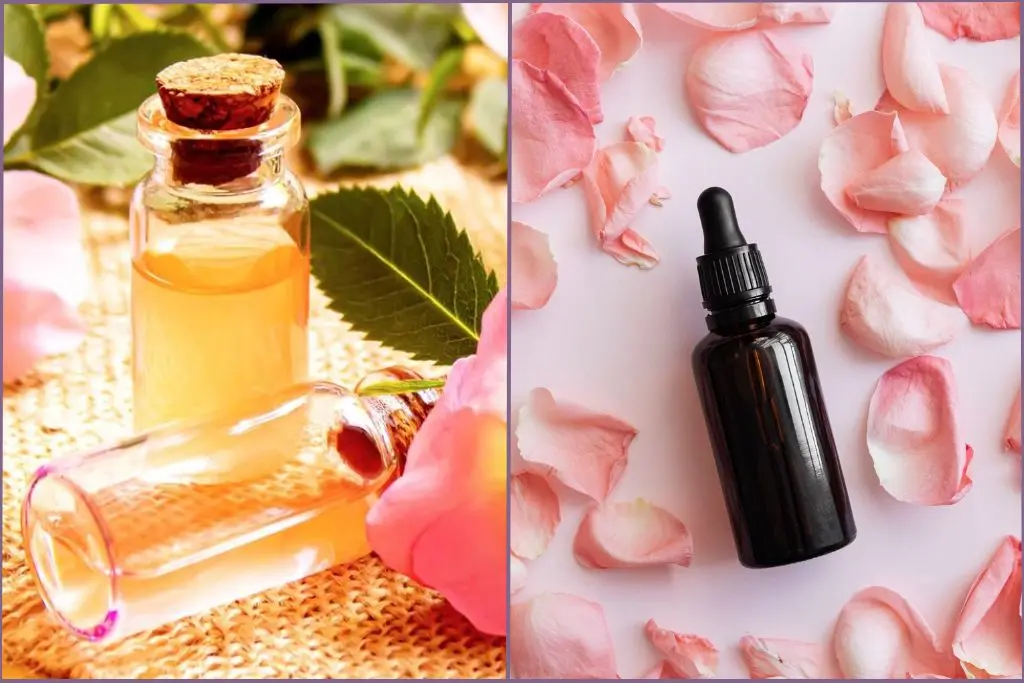
Rose essential oil and rose-infused oil are two different products with distinct properties.
Rose essential oil is typically extracted from rose petals using steam distillation and contains highly concentrated rose fragrance and therapeutic properties.
On the other hand, rose-infused oil is created by infusing carrier oil with dried rose petals, resulting in a milder rose scent and the beneficial properties of the carrier oil. While both oils offer unique benefits, the choice between them will depend on personal preference and specific use case.
15+ Creative Ways to Use Rose Infused Oil
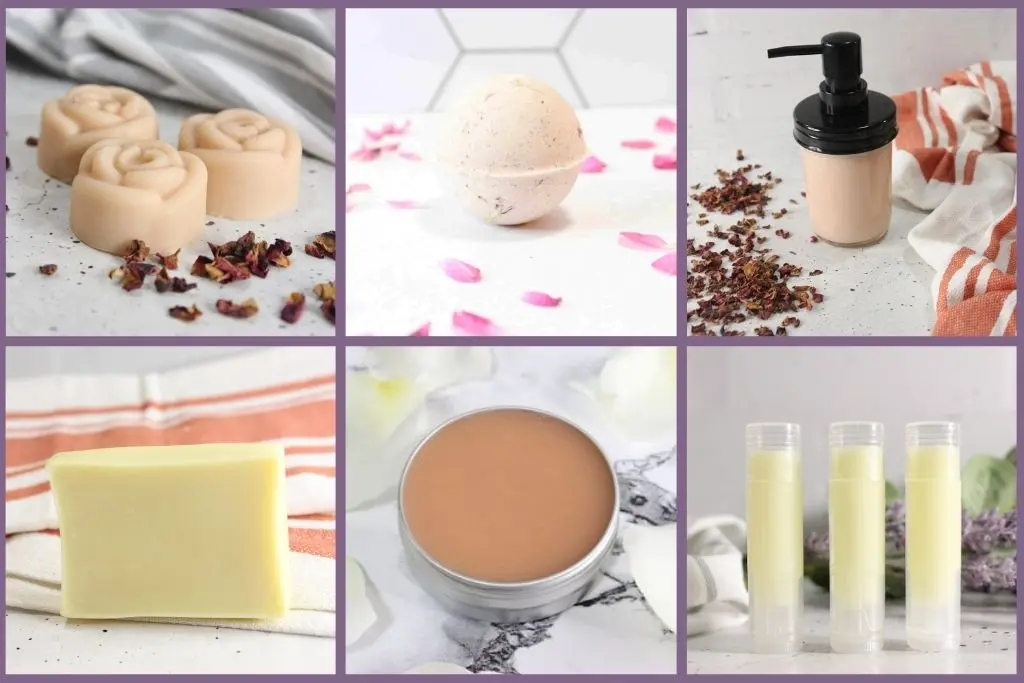
Homemade rose oil adds gentle care and luxury to your daily routine. Its natural floral aroma and soothing properties make it a favorite in lifestyle and aromatherapy recipes.
Here are some inspiring ways to use your homemade oil:
1. Luxurious Body Butter
Rose oil transforms any body butter recipe into a deeply moisturizing, aromatic treat for your skin. Its soothing scent balances well with vanilla or lavender, adding softness and a gentle floral aroma. The emollient properties of rose oil will leave your skin smooth and glowing.
2. Gentle Rose Lotion Bars
Rose-infused oil is the base for gentle floral lotion bars, which melt on contact with skin to leave lasting moisture. The rich floral note of rose is a bonus, making each use feel special and pampering.
3. Aromatic Bath Oil
Add a tablespoon of rose-infused oil to a warm bath for a calming soak. The oil creates a light layer over your skin, locking in moisture and leaving it silky after you towel off. The natural fragrance brings a touch of rose garden luxury while you unwind.
4. Rich Rose Lotion
Stir rose oil into your homemade lotion for a hydrating floral touch. Its calming aroma and skin-loving properties help nourish dry areas without being too heavy. Pair with geranium or bergamot for a brighter, more uplifting scent combination.
5. Floral Scented Solid Perfume
Create a solid perfume using rose oil, beeswax, and jojoba oil for an easy on-the-go scent. A dab on the wrists or neck surrounds you with delicate floral notes. The rose aroma is gentle enough for daily wear and adds a natural lift to your mood.
6. Nourishing Cuticle Oil
Rose oil softens dry cuticles and strengthens nails. Its lightweight texture sinks in quickly and can be paired with a drop of vitamin E for extra moisture. The subtle rose scent makes this step a daily treat.
7. Soothing Facial Serum
A few drops of rose oil in your serum help calm and hydrate your skin, thanks to its balancing qualities. Blending with sweet almond or argan oil creates a light, nourishing serum suitable for most skin types. The gentle floral aroma makes your skincare routine more relaxing.
8. Overnight Hand or Foot Treatment
Massage rose-infused oil into your hands or feet before bed, then slip on cotton gloves or socks. The oil deeply hydrates dry, rough skin overnight, while the gentle floral aroma soothes your senses for more restful sleep. Wake up to softer skin and a lingering touch of rose.
9. Aromatic Reed Diffuser
Use rose oil as a base for a simple, elegant reed diffuser. The steady release of its natural fragrance fills your space with a light, calming rose scent, perfect for creating a peaceful home environment.
10. Relaxing Massage Oil
Combine rose oil with light carrier oils like grapeseed for a soothing and aromatic massage blend. It brings instant calm, ease, and comfort to tired muscles while the floral scent encourages relaxation. Scent pairings like sandalwood or chamomile can also enhance the spa-like experience.
11. Nourishing Lip Balm Base
Use rose oil as a base when making homemade lip balm. Its moisturizing properties help protect and soften your lips, while the subtle rose scent feels calming and elegant. Pair with a little honey or vanilla for added comfort and flavor.
12. Skin-Friendly Body Scrub
Recplace carrier oil with rose-infused oil in any of these sugar scrub recipes. The exfoliation removes dead skin cells, while the oil leaves your skin smooth, hydrated, and delicately scented. Rose oil’s calming scent turns your scrub routine into a relaxing mini spa ritual.
13. Shine-Boosting Hair Oil
Rose oil tames frizz and adds a healthy sheen to the ends of your hair. The subtle fragrance blends nicely with ylang-ylang or a hint of citrus, offering aromatherapy each time you smooth your hair. Try just a drop to avoid weighing your hair down.
14. Calming Pillow Mist
Mix a small amount of rose infused oil with water in a spray bottle to create a calming pillow mist. Lightly spray your pillowcase or linens before bedtime. The floral aroma creates a tranquil environment and helps signal your mind that it’s time to unwind.
15. After-Sun Skin Soother
Combine rose-infused oil with aloe vera gel for a gentle after-sun skin treatment. Rose oil’s soothing qualities help calm redness and keep your skin hydrated, while aloe adds extra coolness. The soft fragrance makes this a refreshing way to care for your skin after sun exposure.
16. Assorted Homemade Bath And Beauty Products
Rose-infused oil made from organic petals makes a great base for a wide range of homemade bath and beauty products. Use it to make rose bath bombs, rose-scented bath salts, sugar scrubs, soaps, and lip balms.
17. Gift It
Rose-infused oil can also make a lovely gift for any occasion. Package the homemade infusion in a pretty glass bottle and add a few dainty accessories to decorate the bottle. Don’t forget to include a label and a handmade card with instructions on how to use the contents!
You can also blend your rose oil with other natural ingredients for scrubs, salt soaks, or even as the base for gentle deodorant creams.
Learning how to make rose-infused oil using either dried or fresh petals is rewarding and much easier than it might seem. Whether you choose fresh petals and enjoy the bright, romantic scent, or go with dried petals for a deeper aroma, both methods bring out the true beauty of roses. With just a few simple steps, you can create a custom oil that suits your style and needs.
This homemade oil adds a natural touch to your skincare, bath, or hair routine – plus, it makes a thoughtful gift.
Looking to make skin-friendly infused oils with other botanicals? You’ll find detailed recipes and step-by-step guides on how to make calendula-infused oil, rosemary lavender-infused oil, arnica oil, and coffee-infused oil.
Rose Oil DIY: Frequently Asked Questions

What type of roses work best for making rose oil?
Fragrant roses like Damask or Rosa Centifolia give the richest scent. Garden or organic roses are best, since they’re not sprayed with chemicals.
Can I use any type of carrier oil to make rose infused oil?
You can use a variety of carrier oils to make rose oil. It’s best to choose a lightweight carrier oil that’s easily absorbed by the skin and won’t overpower the scent of rose petals. Jojoba, sweet almond, and grapeseed oil work well for this purpose.
How long does homemade rose oil last?
Rose oil made from dried petals will stay fresh for up to 6 months if stored correctly. Rose oil made from fresh petals will stay fresh for up to 3-4 months.
Should the jar stay sealed while infusing?
Yes, keep the lid tightly closed. This keeps the scent from escaping and prevents dust from getting in.
Can I speed up the process by heating the oil?
You can gently heat the oil and petals in a double boiler for a few hours. Keep the heat low to avoid damaging the scent. Never use a microwave as it damages the delicate properties of the rose petals.
Can I use homemade rose oil on my skin?
Rose oil made as described (without additives) is fine for most people for external use, like in a bath or as a massage oil. Always test a small spot on your skin first.
How can I make the scent of the infusion stronger?
To get a stronger infusion, steep fresh batches of rose petals in the same oil several times. The more times you repeat, the richer the scent of the infusion.
Can I add other botanicals to the infusion?
Yes, you can add other botanicals such as lavender, chamomile, or calendula to the infusion for added benefits and fragrance.
Don’t Have Time To Make Your Own Floral Infused Oil?
Not everyone has the time or inclination to make their own herbal infusions, and that’s completely understandable.
If you’re looking for premade options, Provence Beauty Rose Multi-Use Oil has received great reviews. It contains an organic blend of Apricot, Vitamin E, and Sweet Almond oils and is an excellent moisturizer for Dry Skin, Scalp & Nails. With over 17,200 five-star reviews, you know you can’t go wrong with this premade rose-infused oil.
